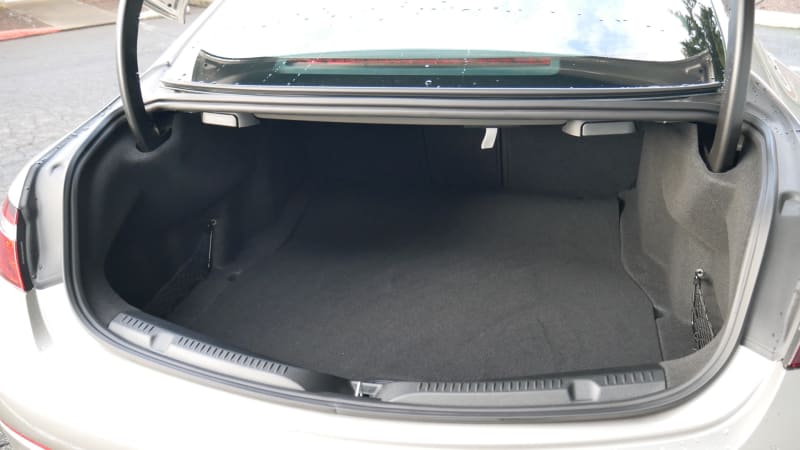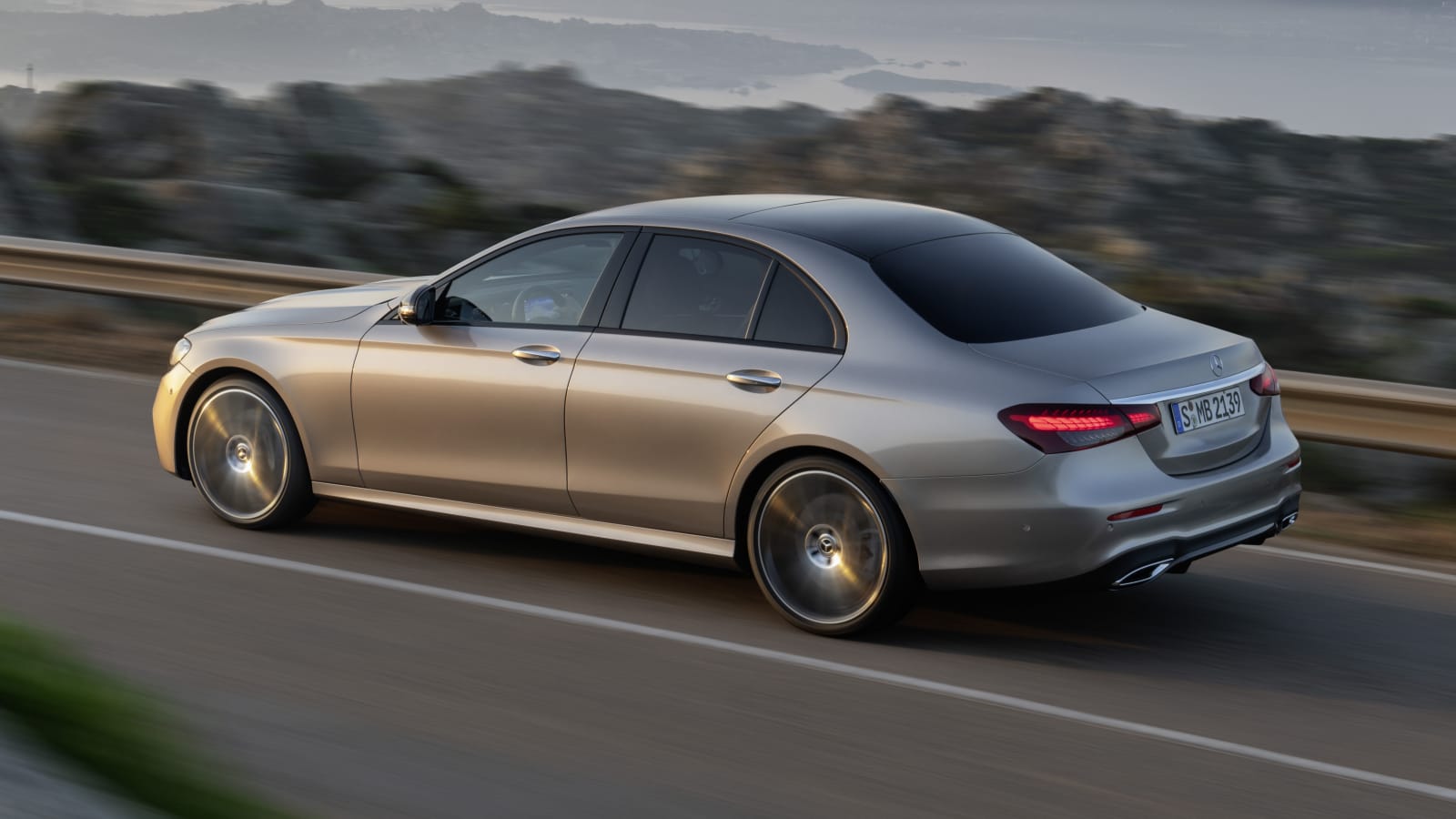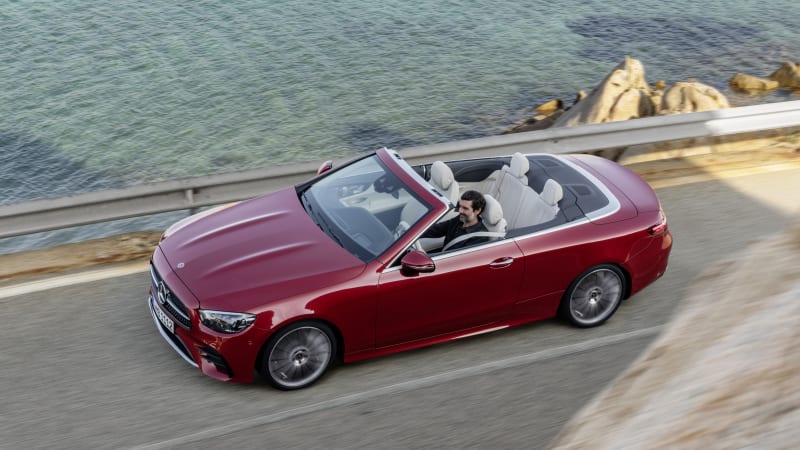The Mercedes-Benz E-Class is not the most recently redesigned midsize sedan in its segment, but it remains the benchmark for the segment. Yes, a car that dates back to 2017 with a refresh for 2021 is still one of the best midsize luxury sedans you can buy. There are quite a few reasons for that. It has superb powertrains on offer from the entry-level to the high-performance AMG models. It has superb interior design with top-notch materials. And, beyond the sedan, it’s available in a variety of body styles: coupe, convertible and wagon.
Even with the V8 models currently unavailable, the E-Class still features a turbocharged four-cylinder and a pair of six-cylinder engines that offer impeccable smoothness, power and refinement. The interior in particular looks as fresh as the day it launched with its metal trimmings and vents, wood accents and flashy ambient lighting and screens. It also features up-to-date Mercedes infotainment and voice controls thanks to the 2021 refresh.
Then there is the body style and trim level selection. In addition to the traditional sedan, there are coupe, convertible and All Terrain wagon versions. The coupe is particularly sharp with its pillarless hardtop design, and the wagon offers impressive practicality. And if you need performance, the AMG 53 variants offer plenty of power and impressive handling. This level of selection is practically impossible to find in this segment.
If the E-Class has one weakness, it’s the lack of hybrid or ultra-high performance models. Without the V8-powered AMG 63 options for 2022, the E-Class is temporarily outgunned by the BMW M5, Cadillac CT5-V Blackwing, Porsche Panamera Turbo and Audi RS 6 Avant. On the opposite end of the spectrum, BMW, Audi and Porsche all have plug-in hybrid variants in this size range, too.
Interior & Technology | Passenger & Cargo Space | Performance & Fuel Economy
What it’s like to drive | Pricing & Features | Crash Ratings & Safety Features
What’s new for 2022?
The E-Class was given a mid-cycle refresh for the 2021 model year, so updates for 2022 are very minimal. Automatic high-beam headlights are now standard, and Nautical Blue Metallic is a new paint color. The E 53 also now has a standard heated steering wheel. V8 versions of the E-Class are also still not available due to supply shortages. Some Mercedes models have regained their V8 options, but the E-Class has not.

What are the E-Class interior and in-car technology like?
Mercedes-Benz is safely in first place when it comes to German luxury car interiors, and the E-Class is no exception. The general design is consistent across all versions of the E-Class, so far as the dash layout is concerned. It flows from one side to the other with elegant lines and beautiful flourishes. Materials are all top of class and feel like genuine luxury when you start moving your hand around the various surfaces. Good luck customizing the interior to the exact way you’d like, as the upholstery and trim options never seem to end. You can choose traditional leather colors and patterns or go with bright and vibrant accents. The options change depending on what level of performance E-Class you bought, giving way to even more customization options. So long as you actually like the basic design of the interior, we’re almost certain that you can find a spec to fall in love with.
Mercedes crams this car full of so much tech that you’re going to need to read the owner’s manual three times over before you start to understand how to use it all. It can be overwhelming, even if the multiple ways of controlling the system at least allows you to choose your preferred input method. The instruments and infotainment are in parity with most other Mercedes models with a very capable voice control system and a touchscreen. With the 2021 refresh, Mercedes also replaced the classic scroll wheel with a haptic touchpad that can also control the infotainment, which is reminiscent of the Lexus Remote Touch pad. It’s not as quick and responsive as the scroll wheel it replaces, but the touchscreen addition makes it a wash. The steering wheel was also updated for 2021, and it dropped all of its physical controls for touch-sensitive ones, which is a definite downgrade, even if the wheel design is handsome.
The customization continues with the configurable instrument panel, which features different themes and layouts, and a near-infinite array of ambient lighting choices. The LED lights are integrated all throughout the cabin, and you can make them whatever color you want. It may sound cheap or gimmicky, but somehow Mercedes has found a way to make the interior even richer and classier with this lighting. And finally, you can even choose how your E-Class smells. An optional fragrance diffuser can dispense your selection of questionable-smelling, cologne-like substances through the air vents, just as you’re beginning one of the many massage programs available in the seat settings — we promise, testing this was actually very hard work.
How big is the E-Class?
This question is highly dependent on the version of E-Class you’re looking at. A wagon will be the most practical, with the sedan coming in right after that. All the versions of the E-Class would fall under the midsize category of luxury cars, so that puts it in the same class as the BMW 5 Series, Audi A6, Jaguar XF and Volvo S90. Front seat space is reasonably roomy, though head room is a bit tight.
Sitting in the sedan and wagon’s backseat is plenty comfortable for adults, but the middle seat isn’t ideal due to the tall middle hump. Passengers also have more space in the E-Class Coupe and Cabriolet than other two-door luxury vehicles (of which there are admittedly few), but they’re much more cramped and difficult to get in and out of than the four doors.
When it comes to cargo space, the sedan only has a 13.1-cubic-foot trunk, which is quite small for such a big sedan. The coupe is also comparably small at 10 cu-ft (below right), while the Cabriolet (9.5) is actually OK for a convertible with the roof raised. There are no such space issues in the wagon, though. It’s enormous, with a bountiful 35 cu-ft of cargo space behind the rear seats. Put them down and there’s a massive 64 cu-ft, which is comparable to many midsize SUVs. Oh, and it’s available with an old-school, rear-facing third-row seat in that cargo area (below left).
What are the E-Class fuel economy and performance specs?
With the V8 E-Class models currently out of commission, there are only three available engine options. The sedan gets all three options, starting with the E 350’s turbocharged 2.0-liter four-cylinder that makes 255 horsepower and 273 pound-feet of torque. It comes with a nine-speed automatic and can be paired with rear- or all-wheel-drive. It propels the sedan to 60 mph in about 6 seconds depending on the driveline. The rear-drive model delivers combined 26 mpg, and the all-wheel-drive one delivers 24 combined mpg.
In the middle of the line-up is the first of two turbocharged 3.0-liter straight-six engines. It comes in the E 450 and makes 362 horsepower and 369 pound-feet of torque. It also features a 48-volt mild-hybrid assist that assists with pulling away from a stop, smoothing out the start-stop system, and allowing coasting. Like the four-cylinder, the six gets a nine-speed automatic and, depending on body style, can have rear- or all-wheel-drive. The E 450 coupe and convertible come standard with rear-wheel drive or optional all-wheel drive, whereas the sedan and All Terrain wagon get all-wheel drive standard. The 0 to 60 mph times range between 5.2 and 4.9 seconds, and combined fuel economy ranges between 24 and 25 mpg.
The current range-topper is the six-cylinder in the E 53 coupe, convertible and sedan. In addition to the conventional turbocharger and 48-volt hybrid assist motor, this engine also picks up an electrically-driven auxiliary turbo, which sharpens throttle response. Power rises to 429 horsepower, and torque to 384 pound-feet. An AMG-tuned nine-speed automatic and all-wheel drive are standard across all body styles. They run to 60 mph in 4.3 to 4.4 seconds, and fuel economy ranges from 22 to 24 mpg combined depending on the body style.
What’s the E-Class like to drive?
Just as one would expect, the varying levels of performance create huge differences in the driving experience. A normal E 350 Sedan is sedate, quiet and comfortable, whereas the E 53 has a slick and punchy six cylinder, plus very sharp handling to go with its refinement. The E-Class isn’t the most fleet of foot with the four-cylinder, so we’d suggest driving it and one of the six-cylinder variants before deciding.
There are two six-cylinder engines available, and now both the E 450 and the E 53 get versions of the fabulous turbocharged 3.0-liter straight-six. As power junkies, we’ll still go with the E 53 variant for its extra grunt as well as its incredible engine response thanks to its extra electrically-driven turbocharger. But both engines are smooth as silk and make some of the best noises in the automotive world today. Seriously, this thing sounds better than BMW’s vaunted inline-sixes. Not only that, but it’s the perfect balance of speed and usability on the street. Really, it splits the difference between the E 450 and the radical, but still missing in action E 63 S, landing right in the sweet spot. The ride is comfortable when you want it to be, but the suspension can be stiffened enough to provide excellent handling on a twisty road.
What other Mercedes-Benz E-Class reviews can I read?
2021 Mercedes-Benz E 450 Sedan First Drive Review
Fully detailing the changes made last year that carry over into 2022.
2021 Mercedes-Benz E 450 Coupe Road Test
There’s really nothing else like it out there, and that’s a shame. The E-Class Coupe is just wonderful as we detail in this road test.
2021 Mercedes-Benz E 450 All-Terrain First Drive Review
Our review of the new All-Terrain wagon. Despite the more rugged looks and slight ground clearance increase, the All-Terrain offers little advantage over the plain-old E-Class wagon it replaces.
2019 Mercedes-AMG E 53 Cabriolet Review | A first taste of AMG’s hybrid, L.A. style
We drive around L.A. in the Cabriolet flavor of E 53. Although it was updated last year our overall impressions remain the same.
How much is the 2022 E-Class price and what features are available?
The base E 350 sedan starts at $56,000, including the reasonable $1,050 destination charge. It includes the four-cylinder engine and rear-wheel drive. It also comes pretty well-equipped. On the outside it has 18-inch alloy wheels, LED lighting and a sunroof. Inside, it features power, heated seats with memory, dual 12.3-inch screens for instruments and infotainment, dual-zone automatic climate control, proximity keys with push-button start, Apple CarPlay and Android Auto, 64-color ambient lighting and navigation. These are also pretty much the same standard features for the other E-Class models, too.
Base prices for the E-Class lineup are listed below.
Sedan
- E 350: $56,000
- E 450: $63,800
- E 53: $76,050
Wagon
- E 450 All-Terrain: $69,450
Coupe
- E 450: $67,150
- E 53: $78,650
Convertible
- E 450: $74,300
- E 53: $85,400
What are the E-Class safety ratings and driver assistance features?
Standard safety features include automatic emergency braking, blind-spot monitoring, automatic high-beam headlights and rain-sensing wipers. Available as options are adaptive cruise control with stop-and-go and lane-centering steering assist, enhanced forward collision prevention, automated lane-changes, automated parking, parking sensors, rear cross-traffic alert and surround view cameras.
The E-Class sedan and wagon have earned high safety marks, but the coupe and convertible have not been tested by either NHTSA or IIHS. In NHTSA testing, the sedan and wagon both were given five-star ratings overall, with five-star ratings in each individual category of front, side and rollover crash testing. The IIHS has only tested the sedan, but it performed extremely well having earned the Top Safety Pick + award. Each crash test resulted in the best “Good” rating, and headlights ranged between “Acceptable” and “Good.” The standard and optional forward collision prevention system also got the “Superior” rating for vehicle-to-vehicle situations. However, for vehicle-to-pedestrian situations, the optional version was rated Superior, but the standard version was just rated as “Basic.”
Source: www.autoblog.com













